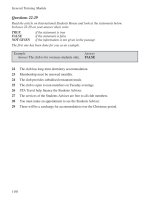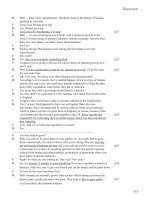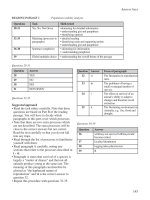Cambridge Practice Tests for IELTS part 9
Bạn đang xem bản rút gọn của tài liệu. Xem và tải ngay bản đầy đủ của tài liệu tại đây (118.86 KB, 15 trang )
115
Tapescripts
M: Well after some consideration I decided to look at the history of banana
growing in Australia.
F: (surprised) Banana growing!
M: Yes, banana growing.
F:
(sarcastically) Fascinating, Im sure! Q21
M: Well its not as boring as youd think. And I wanted to tie it in to the
work Ive been doing on primary industries and the economy. Anyway I bet
there are a few things you didnt know about bananas!
F: Such as?
M: Such as the fact that bananas were among the first plants ever to be
domesticated.
F: Oh, really?
M: Yes,
theyre an extremely nourishing food. Q22
F: I suppose youre going to tell me the whole history of banana growing now
arent you?
M: Well, itd be a good practice run for my tutorial next week. Ill do the same Q23
for you some time.
F: OK. Fire away. So where were these bananas first domesticated?
M: According to my research, the Cavendish banana, which is a type of banana
and the first type to be cultivated here, actually originated in China but they
had a fairly roundabout route before they got to Australia.
F: You mean they didnt go straight from China to Australia?
M: No, they didnt. It seems that in 1826, bananas were taken from South China
to England.
F: I suppose they would have made a welcome addition to the English diet.
M: Yes, Im sure. Well apparently there was an English Duke who was
particularly fond of bananas and he used to cultivate them in his hothouse,
which is where you have to grow them in England, of course, because of the
cool climate and they became quite popular in the UK.
So he was the one Q24
responsible for cultivating the Cavendish banana which was then introduced
into Australia.
F: I see. And weve been growing them ever since?
M: Yes.
--------------------------------------------------------------------------------------
F: Are they hard to grow?
M: Well, yes and no. To grow them in your garden, no, not really. But to grow
them commercially you need to know what you’re doing. You see
you only
get one bunch of bananas per tree and it can take up to three years for a tree Q25
to bear fruit if you don’t do anything special to it. But this period is greatly
reduced with modern growing methods, particularly in plantations where you
have perfect tropical conditions.
F: Right! So what are you looking at? One year? Two years?
M: No, no,
around 15 months in good conditions for a tree to produce a bunch of Q26
bananas. And once youve got your bunch you cut the bunch and the plant down.
F: So how do the trees reproduce then?
M: Well, bananas are normally grown from suckers which spring up around the
parent plant, usually just above the plant. They tend to
like to grow uphill Q27
or at least thats the common wisdom.
116
Practice Test 2
F: So that’s why banana plantations are usually on hillsides, is it?
M: Yes. They grow best like that.
F: That’s interesting!
M: If you plant them in rich soil and give them plenty of water at the beginning Q28
of summer, then they should be well advanced by the beginning of winter
when growth virtually stops. But in a country like England, theyre hard to
grow, although you can grow them in a hothouse.
F: But in Australia, its not difficult?
M: No, though even here,
the growers put plastic bags around the bunches to Q29
protect them and keep them warm. If you go up to the banana growing
districts, youll see all these banana trees with plastic bags on them.
F: But how do they stop the bananas going bad before they reach the shops?
M: Well, the banana bunches are picked well before the fruit is ripe. Once you
cut the bunch, the bananas stop growing but they do continue to ripen. The
interesting thing is that once one banana ripens, it gives off a gas which then
helps all the others to ripen so they pretty much all ripen within a few hours Q30
of each other.
F: Amazing! So do we export lots of bananas overseas, to Europe and Asia for
instance?
M: Well, oddly enough, no. I believe
New Zealand takes a small proportion of Q31 or 32
the crop but otherwise
theyre mostly grown for the domestic market, which Q32 or 31
is surprising when you think about it because we grow an enormous number
of bananas each year.
F: Yes, well thank you for all that information. Im sure the tutorial paper will
go really well you certainly seem to have done your research on the subject.
M: Lets hope so.
SECTION 4
J = John
D = Diane Greenbaum
J: Good morning, good morning, everyone, and welcome to our regular lecture
on health issues. This series of lectures is organised by the Students’ Union
and is part of the union’s attempt to help you, the students of this university,
to stay healthy while coping with study and social life at the same time. So Q33
it’s a great pleasure for me to welcome back Ms Diane Greenbaum who is
a
professional dietician and who has been kind enough to give up her time, in Q34
what I know is a very hectic schedule, to come along and talk to us today.
D: Thank you. Thank you very much, John. May I say it’s a pleasure to be
back. Now, stresses at university, being away from home and having to look
after yourselves, learning your way around the campus all contribute to
making it quite hard sometimes to ensure that your diet is adequate. So
today I’m going to talk about ways of making sure that you eat well while at
the same time staying within your budget. Q35
--------------------------------------------------------------------------------------
If you have a well balanced diet, then you should be getting all the vitamins
117
Tapescripts
that you need for normal daily living. However sometimes we think we’re
eating the right foods but the
vitamins are escaping, perhaps as a result of
cooking and anyway we’re not getting the full benefit of them. Now, if you Q36
lack vitamins in any way the solution isn’t to rush off and take vitamin pills.
though they can sometimes help. No it’s far better to look at your diet and
how you prepare your food.
So what are vitamins? Well, the dictionary tells us they are food factors
essential in small quantities to maintain life. Now, there are fat soluble
vitamins which can be stored for quite some time by the body and there are
water soluble vitamins which
are removed more rapidly from the body and
so a regular daily intake of these ones is needed. Q37
OK, so how can you ensure that your diet contains enough of the vitamins
you need? Well, first of all, you may have to establish some new eating
habits! No more chips at the uni canteen, Im afraid! Now firstly, you must
eat a variety of foods. Then you need to ensure that you eat at least four Q38
servings of fruit and vegetables daily. Now youll need to shop two or three
times a week to make sure that theyre fresh, and store your vegetables
in the
fridge or in a cool dark place. Q39
Now let s just refresh our memories by looking at the Healthy Diet
Pyramid. OK, can you all see that? Good. Well ,now, as you see weve got
three levels to our pyramid. At the top in the smallest area are the things
which we should really be
trying to avoid as much as possible. Things like
Example yes, sugar, salt, butter all that sort of thing.
Next, on the middle of our pyramid we find the things that we can
eat in
moderation. Not too much though! And thats where we find milk, lean meat, Q40
fish, nuts, eggs. And then at the bottom of the pyramid are the things that
you can
eat lots of! Because theyre the things that are really good for you Q41
And here we have bread, vegetables and fruit. So dont lose sight of your
healthy diet pyramid when you do your shopping.
SECTION 1
M = Male student
F = Female student
C = Clerk
M: How do you come to the university each day? Train or bus or do you have a
car?
F: Oh, I always walk — I haven’t got a car and anyway I live quite close. Example
Repeat
M: Do you know anything about parking rights on the campus? I was wondering
whether students are allowed to park their cars on the campus or not?
PRACTICE TEST 3
118
Practice Test 3
F: Yes, I think it’s possible for post graduate students but not for Q1
undergraduate students.
M: That doesn’t seem very fair.
F: No, I suppose not, but there simply isn’t enough room on the campus for
everyone to park.
M: Do you need a parking permit?
F: Yeah, I believe you do.
M: Where do I get that from?
F: I think you can get a parking sticker from the administration office.
M: Where’s that?
F: It’s in the building called
Block G. Right next to Block E. Q2
M: Block G?
F: Yeah.
M: Oh right. And what happens to you if you don’t buy a sticker? Do they
clamp your wheels or give you a fine?
F: No, I think
they tow your car away. Q3
M: Oh really?
F: Yeah.
And then they fine you as well because you have to pay to get the car Q3
back.
M: I’d better get the sticker then.
F: Yeah.
M: Where exactly is the administration office again? I’m new to this university
and I’m still trying to find my way around.
F: Right. You go along Library Road, past the tennis courts on your left and
the swimming pool on your right and the administration office is opposite
the car park on the left. You can’t miss it.
M: So it’s up Library Road, past the swimming pool, opposite the car park. Q4
Right, I’ll go straight over there. Bye and thanks for the help.
--------------------------------------------------------------------------------------
C: Good morning, can I help you?
M: Yes, I was told to come over here to get a parking sticker. Is this the right
place?
C: Yes, it is. Are you a post graduate student?
M: Yes, I am.
C: OK, well, I’ll just need to take some details ... Your name?
M: Richard Lee — that’s spelt L double E. Q5
C: Richard ... Lee. And the address?
M: Flat 13,
30 Enmore Road Q6
C: How do you spell Enmore?
M: E-N-M-0-R-E. And that’s in the suburb of Newport: N-E-W-P-0-R-T. Q7
C: Faculty?
M: I beg your pardon?
C: Which faculty are you in?
M: Architecture, the Faculty of Architecture. Q8
C: Right ... and the registration number of your car?
M: Let me see um L X J five oh ... No, sorry, I always get that wrong, it’s
LJX 058K. Q9
C: LJX 508K.
119
M: No … 058K
C: Ah. And what make is the car?
M:
It s a Ford Q10
C: A Ford. Fine! Well, I’ll just get you to sign here and when you’ve paid the
cashier I’ll be able to issue you with the sticker.
M: Right. Where do I pay?
C: Just across the corridor in the cashier’s office. Oh, but it’s 12.30 now and
they close at 12.15 for lunch. But
they open again at a quarter past two until Q11
4.30
M: Oh .. they’re not open till quarter past two?
C: No. When you get your sticker, you must attach it to the front windscreen of Q12
your car. I m afraid it’s not valid if you don’t have it stuck on the window.
M: Right, I see. Thanks very much I’ll just wait here then.
SECTION 2
Guide:
Good morning everyone, and welcome to the Maritime Museum.
Now before we commence our tour I’d just like to tell you a little bit about the
history of the museum As you can see, it’s a very modern building built in the
post modern style and it was in fact opened by the Prime Minister of Australia
in
November 1991. It’s been designed with a nautical flavour in mind to remind us of Q13
our links with the sea. But the museum isn’t only housed in this building, there are
a number of historic ships docked outside in the harbour which form part of the
museum and which you are also free to visit, and we’ll be coming to them shortly Q14
I’d just like to point out one or two things of general interest while we’re here.
Handicapped toilets are located on this floor and the door shows a wheelchair. Example
The cloakroom where you can hang your coat or leave your bags is just behind us
here. The education centre is on the top floor and there’s a good little library in
there which you might like to use. Follow the signs to the Education Centre —
you’ll see a lot of little green arrows on the wall. The green arrows will take you Q15
there. The information desk, marked with the small letter i on your plan is located
right here in the foyer, so if you get separated from your friends, I suggest you
make your way back to the information desk because we’ll be returning to this Q16
spot at the end of the tour. All right?
Now if you look out this window you should be able to see where the
museums ships are docked. If you want to go on a tour of the old ship, the
Vampire , shes docked over there and you should meet outside on the quay.
However a word of warning! I dont recommend it for the grandmas and
grandpas because there are lots of stairs to climb. Right, now, lets move on Q17
Oh, I almost forgot to give you the times for that tour. Now, tours of the Vampire
run
on the hour every hour. All right? Q18
--------------------------------------------------------------------------------------
Let’s take a walk round the museum now. The first room we’re coming to is the
theatre. This room is used to screen videos of special interest and we also use it for
lectures. There’s a continuous video showing today about the voyages of
Captain
Tapescripts
120
Practice Test 3
Cook, so come back here later on if you want to learn more about Captain Cook. Q19
Now, we’re moving along the gallery known as the Leisure Gallery. This is one
of our permanent exhibitions and here we try to give you an idea of the many
different ways in which Australians have enjoyed their time by the sea: surfing,
swimming, lifesavmg clubs,
that’s all very much a part of Australian culture. At the Q20
end of this section we’ll come to the Picture Gallery where we’ve got a marvellous
collection of paintings all by
Australian artists. I think you can buy reproductions Q21
of some of these paintings in the museum shop. Well worth a good look.
Now we’re coming to the Members’ Lounge. As a member of the museum you
would be entitled to use the members’ lounge for refreshments. Membership costs
$50 a year or
$70 for all the family. So it’s quite good value because entry to the Q22
museum is then free.
And down at the far end of this floor, you’ll find the section which we’ve called
Passengers and the Sea. In this part of the museum we’ve gathered together a
wonderful collection of souvenirs from the old days when people travelled by ship. Q23
You’ll find all sorts of things there: old suitcases, ships’ crockery, first class cabins
decorated in the fashion of the day. Just imagine what it must have been like to
travel first class.
Now I’m going to leave you to walk round the museum on your own for a while
and we’ll all meet back again at the information desk in three quarters of an
hour’s time. I hope you enjoy your time with us at the museum today. Thank you.
SECTION 3
T = Tutor
M = Mark
S = Susan
T: OK, everybody, good morning! It’s Mark’s turn to talk to us today so
Mark, I’ll ask you to get straight down to business.
M: Right!
T: Now following on from what we were discussing last week in Susan’s tutorial
on approaches to marketing, you were going to give us a quick run down on
a new strategy for pricing which is now being used by many large companies Q24
known as “revenue management” … before we go on to your actual tutorial
paper on Sales Targets. Is that correct?
M: Yeah, OK, well …
T: So what exactly is revenue management?
M: Well, it’s a way of managing your pricing by treating things like airline
tickets and hotel rooms rather more as if they were perishable goods.
S: Yeah, I just tried to book a ticket yesterday for Perth and would you believe
there are three different prices for the flight?
M: Right! And what was the rationale for that?
S: Well … the travel agent said it depended on when you book and the length
of the stay, like it’s cheap if you stay away for a Saturday night, presumably
because this isn’t business travel and even cheaper if you buy a ticket where Q25









